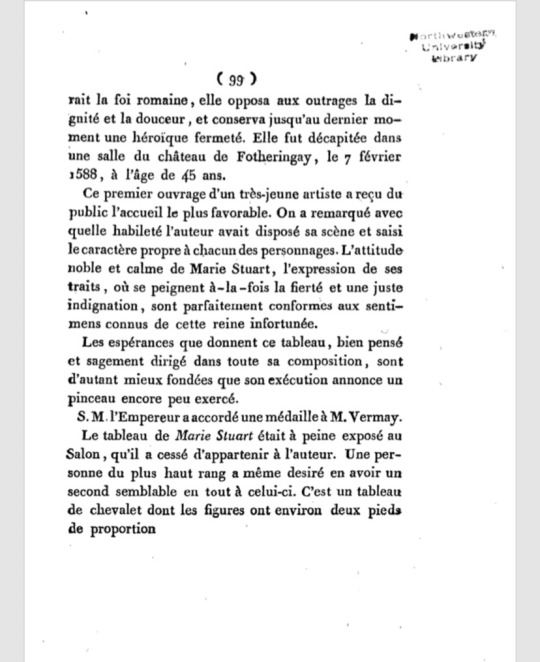#truboudor
Text
Napoleon and Mary, Queen of Scots


Okay @isthenapoleoncute I don’t think this is exactly what you are looking for. But there is an artist, Jean-Baptiste Vermay, who made a painting in 1808 about the death of Mary, Queen of Scots. Title: Marie Stuart, reine d'Écosse, recevant sa sentence de mort que vient de ratifier le Parlement.
Napoleon was Vermay’s patron. He granted Vermay an award for the painting, and he and Josephine requested a replica of it.
Here is some info about the painting published in 1808: Annales du musée et de l'école moderne des beaux-arts: Salon de 1808, par Charles-Paul Landon. There are some really interesting parts. It talks about the long exile and injustice at the hands of the English queen. Also important to note that Mary was apparently Queen of France by marriage (according to this. Idk much about this part of history). So there is a French connection as well; an English ruler exiling a French ruler.


My (loose) translation:
The artful Elizabeth, Queen of England, held Mary Stuart prisoner for eighteen years. Her cruel policy demanded the sacrifice of this illustrious victim; she had Mary, her equal, judged as if she had been her subject. Forty-two members of parliament and five judges of the kingdom went to question her in her prison. She was sentenced to death: parliament confirmed the sentence and requested its execution. Elizabeth signed the fatal order, and the earls of Kent and Schrewbury, responsible for having it executed, accomplished it with a barbarity worthy of their ministry. Mary Stuart received her sentence with tranquility, and even with joy. A long captivity, violent sorrows, early infirmities made her regard death as the end of her sufferings. In her last days, she added to the exercises of courageous piety the most tender care for the people attached to her service; after having written on their behalf to Henry III and the Duke of Guise, she asked that they be witnesses to her torture. “Remember,” she said to Kent, who stubbornly refused her, “remember that I am a cousin of your queen, that I am of the royal blood of Henry III, that I was Queen of France by marriage, that I was crowned Queen of Scotland.”
Inhumanly deprived of all religious assistance, obliged to listen to the exhortations of a fanatic who threatened her with eternal damnation if she did not abjure the Roman faith, she opposed the outrages with dignity and gentleness, and preserved until the last moment a heroic firmness. She was beheaded in a room at Fotheringay Castle on February 7, 1588, at the age of 45.
This first work by a very young artist received the most favorable reception from the public. We noticed with what skill the author had arranged his scene and captured the character specific to each of the characters. The noble and calm attitude of Mary Stuart, the expression of her features, where both pride and righteous indignation are depicted, are perfectly consistent with the known sentiments of this unfortunate queen.
The hopes given by this painting, well thought out and wisely directed throughout its composition, are all the better founded as its execution announces a brush still little practiced.
His Majesty the Emperor awarded a medal to Mr. Vermay.
The painting of Mary Stuart was barely exhibited at the Salon when it ceased to belong to the author. A person of the highest rank even wanted to have a second one similar in every way to this one. It is an easel painting whose figures are approximately two feet in proportion.
#Mary Stuart#Marie Stuart#mary queen of scots#Jean-Baptiste Vermay#Vermay#Landon#Charles Paul Landon#napoleon#napoleonic#napoleonic era#napoleon bonaparte#art#art history#truboudor
33 notes
·
View notes